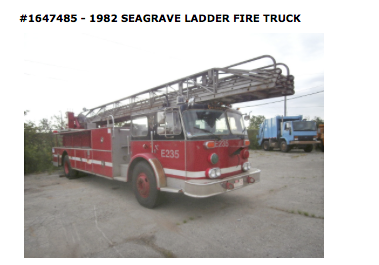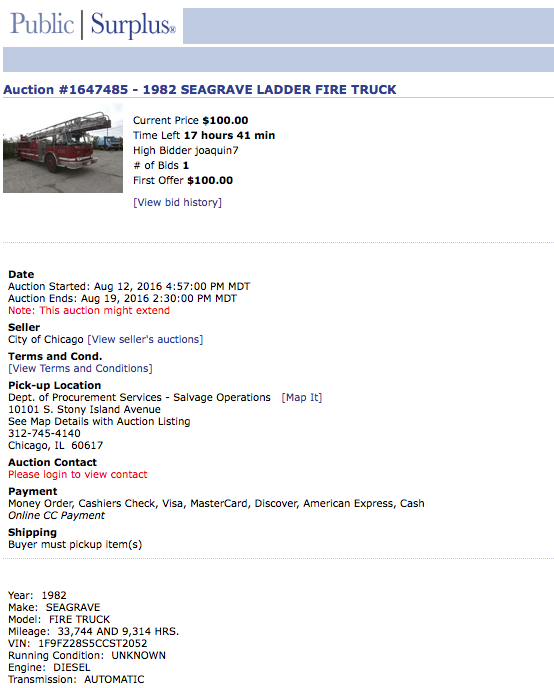This from Danny Nelms:
Seagrave ladder with shops ID E-235 is up for auction now



thanks Callum & Danny
This from Danny Nelms:
Seagrave ladder with shops ID E-235 is up for auction now



thanks Callum & Danny
Tags: Chicago Fire Department, Surplus Chicago Seagrave fire truck for sale, used Chicago fire truck for sale, used Seagrave Chicago FD aerial truck for sale
This entry was posted on August 19, 2016, 3:30 PM and is filed under fire engine for sale. You can follow any responses to this entry through RSS 2.0. Both comments and pings are currently closed.

For the finest department portraits and composites contact Tim Olk or Larry Shapiro.
Arclite theme by digitalnature | powered by WordPress
#1 by Bill Post on August 23, 2016 - 12:58 AM
Fred M, the CFD stopped ordering trucks with booster tanks and reels because they would have been required to have an engineer assigned to the company. Since they weren’t quints, the CFD started removing the booster reels and the tanks.
As regards the Hendrickson/Morita-Lift, Robert J Quinn was the commissioner when that rig was ordered and he was open to trying new and unique designs in apparatus. The Morita-Lift was actually a 135-foot aerial/elevator as there was a small collapsible basket that went up and down the side of the ladder carrying the fire fighters. The Morita-Lift was built by an Asian company. In 1960 under Commissioner Quinn, the Chicago Fire Department also purchased two 144-foot Magirus rear mounted aerial ladders on B-Model Mack chassis. Of course Fire Commissioner Quinn is correctly credited with pioneering and developing the Snorkel for fire fighting purposes and the large deluge wagons known as Big John and Big Moe were also developed under his watch. Chicago’s Air/Sea Rescue helicopter service began in 1965/66 under him as he was a helicopter pilot himself.
Getting back to your question on the Seagrave rear mounted aerials, one of the reasons that they were popular is that the trucks themselves were pretty compact compared to other makes and models, they were pretty maneuverable on Chicago’s streets, and they met the clearances in some of Chicago’s older fire stations.
When Chicago started purchasing the newer Seagrave aerials with the large crew cabs from 1993 through 1996, at least one or more stations couldn’t accommodate the taller trucks.
#2 by Bill Post on August 23, 2016 - 12:16 AM
Thanks for the link to that aerial ladder report Drew. I believe if I’m correct the Grove aerial ladders and tower ladders became part of Ladder Towers, Inc (LTI) shortly after that report.
It’s ironic that during the late 1960’s and early 1970’s when the CFD was purchasing different makes and models of aerial ladders that the CFD purchased five 100-foot Grove ladders on Ward LaFrance chassis however there were never any repeat orders. At the time Chicago was a good Seagrave customer and apparently they liked Pirsch ladders even though they didn’t purchase as many of them as they did from Seagrave. The CFD remounted some of the Pirsch ladders on newer chassis however. They remounted one from a wrecked 1968 chassis onto a new Ford in 1978, and they remounted four 1966 100-foot ladders that were originally mid mounted on Mack chassis. These were made into rear mounts on Ford chassis in 1988.
Getting back to Grove/LTI products, after that aerial ladder failure in New York City, the FDNY continued purchasing Seagrave ladders so apparently Seagrave made the required modifications to meet the new standards. Only over the last few years did New York City started purchasing rear mount ladders from Ferrara, however they still have been purchasing tillered aerial ladders from Seagrave.
All of those ladders that were involved in the accidents were of the old design, so I must also assume that when Chicago was purchasing Seagrave ladders from 1993 through 1996 they were already using the new design that met the new NFPA 1904 standards.
One department that stopped purchasing Seagrave ladders at the time was the Los Angeles City. Before 1993 the LAFD was almost exclusively a Seagrave customer when it came to aerial ladders. Since 1993, all of their aerial ladders were LTI products. When American LaFrance purchased LTI they started using the ALF chassis. Since ALF went out of business for the first time in 23 years the Los Angeles City Fire Department recently ordered aerial ladders that were not LTI models. They are currently getting their first Pierce aerials delivered.
#3 by Drew Smith on August 22, 2016 - 9:11 PM
To finish my comment, it may be a conclusion that the requirements imposed by NFPA 1904 required a substantial modification and/or redesign by Seagrave and ALF allowing other manufacturers to enter the market.
#4 by Drew Smith on August 22, 2016 - 9:10 PM
It is worthy to note that in the late 1980s the NFPA 1901 committee decided that aerial apparatus needed its own standard. The first edition of NFPA 1904, Standard for Aerial Ladder and Elevating Platform Fire Apparatus, was issued January 11, 1991. Prior to this standard aerials were only mentioned in a single chapter of NFPA 1901, Standard on Automotive Fire Apparatus.
Some might say this is typical NFPA overkill but a series of fatal and dramatic aerial failures triggered this change. Prior to the 1991 edition of NFPA 1904 no minimum performance criteria for aerial tip load existed. Each manufacturer did what they thought was best. The gamut ran from straight aerials that could only manage a 200 pound tip load to the Grumman aerial platform which could easily support 4-5 times that amount. The Grove aerial (made by the Grove crane company) was another stand-out performer but had only a fraction of the market then dominated by Seagrave and American LaFrance.
In April, 1996 the United States Fire Administration released its technical report on Aerial Ladder Collapse Incident, USFA-TR-081. Five aerial failures are discussed. Of note is that the main incident was in the FDNY and on page 11 it notes that the aerial in question was one of 65 similar Seagrave aerial in service at the time of the incident and the particular aerial was a 1992 model that was only four years old at the time of the failure. One of the other failures was in Mundelein, IL. The entire report can be found here https://www.usfa.fema.gov/downloads/pdf/publications/tr-081.pdf
#5 by Fred M on August 22, 2016 - 9:25 AM
Bill, I notice many early models (’67 to ’72) had pumps, booster tanks, and they even bought 2 ’67 mid-ship 100’footers.
Most of the changes look subtle between years and models, but they sure seemed popular/reliable since CFD bought so many. In’69 they bought 10!? However, it looks like they were still trying others such as Mack/Pirsch and Ward LaFrance (later models American LaFrance)….even Hendrickson/Pierce (1). Was Seagrave the main because it was so reliable and easy to maintain??
#6 by Bill Kugelman on August 19, 2016 - 9:10 PM
I also have a 1985 100′ Seagrave Aerial that was T-57s. $5g takes it as is. 773-206-9555
#7 by Bill Post on August 19, 2016 - 4:47 PM
How the mighty have fallen. That model Seagrave aerial ladder was at one time one of the most popular and numerous aerials in the CFD fleet. The CFD purchased about 40 from 1968 through 1982 and about 19 of them were rebuilt in the early 1990’s. That type of Seagrave was also popular in the New York City Fire Department however the ones in New York had the body modified with enclosed crew cabs and what was called the “phone booth”; an enclosed riding compartment just behind the cab which was used by the 7th man. Most of New York’s truck companies normally ran with seven men assigned to them until the late 70’s /early 80’s and then they went down to six which is still the normal assignment. Until just a few years ago many of New York’s engines were running with six. Now just the squads and the hazmat support engines have six. The rest of the engines are running with five which by Chicago standards is normal, but unheard of for most other fire departments.